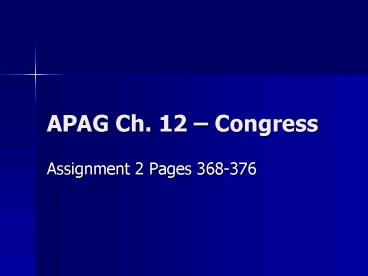APAG Ch' 12 Congress PowerPoint PPT Presentation
1 / 29
Title: APAG Ch' 12 Congress
1
APAG Ch. 12 Congress
- Assignment 2 Pages 368-376
2
- 1. What does bipartisan mean? Give an example of
partisanship.
3
- Bipartisanship is something that has the support
of both Democrats and Republicans. - Judiciary committees vote along party lines.
- Impeachment of Clinton
4
- 2. What is reapportionment? Redistricting?
Justiciable Questions?
5
- Reapportionment is the allocation of seats in the
House of Rep. to each state after each census. - Redistricting is the redrawing of the boundaries
of the congressional districts within each state. - Justiciable Question is one that may be raised
and reviewed in court.
6
- What was significant about these three cases
- a) Baker v. Carr
- b) Reynolds v. Sims
- c) Wesberry v Sanders
7
- In Baker, the Court made reapportionment a
justiciable question. - In Reynolds, the Court held that both chambers of
a state legislature must be apportioned with
equal populations in each district- one person,
one vote - In Wesberry, the Court held that this one
person, one vote applied to congressional
districts too.
8
- 4. What is gerrymandering? What did the Court
say about it in Davis v. Bandemer?
9
- Gerrymandering is the drawing of legislative
district boundary lines for the purpose of
obtaining partisan or factional advantage. A
district is said to have been gerrymandered when
its shape is altered substantially by the
dominant party in a state legislature to maximize
its electoral strength at the expense of the
minority party.
10
- The Court ruled in the Davis case that
redistricting for the political benefit of one
group could be challenged on constitutional
grounds. However, in this particular case, the
Court did not agree that the districts were drawn
unfairly.
11
- 5. What is packing and cracking? How many
seats in the House of Rep. were open for real
competition in the 2002 Congressional elections?
12
- Packing and cracking is the use of powerful
computers and software that packs voters
supporting the opposing party into as few
districts as possible or crack the opposing
partys supporters into different districts. - Only 30-50 seats out of 435 were really open in
the 2002 Congressional election.
13
- 6.What are minority-majority districts? What
has the Court ruled about them?
14
- They are gerrymandering districts to make sure
that a minority population becomes the majority
in order to win a seat. - The Supreme Court has ruled consistently that
race-based districting is unconstitutional.
15
- 7. What are some of the pay, perks, and
privileges that members of Congress receive?
16
- In 2002, annual congressional salaries were
150,000. - They have access to a private gym, free parking
at Dulles airport and on Capitol Hill, subsidized
dining, free medical care, inexpensive but
generous pensions, liberal travel allowances, and
special tax considerations.
17
- Franking privilege-free mail
- A large personal staff
- Average of 30 per senator
- Average of 15 per house member
- Protected from arrest except for treason, felony,
and breach of the peace while in office. - Protected from libel or slander suits while in
office.
18
- 8. Where is most of the work done for
legislating? Who controls most bills?
19
- In committees or subcommittees.
- Committees control most bills.
- Most bills die in the committees.
20
- 9. What is required to get a bill out of a
committee that doesnt want to release the bill?
21
- Discharge petitionwhich must be signed by a
majority of the House members (218) to release
the bill.
22
- What is the importance of each of these
committees - a) Standing Committees
- b) Select Committees
- c) Joint Committees
- d) Conference Committees
- e) House Rules Committee
23
- Standing Committees are the most important of all
committees in Congress. They are permanent
bodies that are established by rules of each
chamber and consider bills within a certain
subject area. The most important of these are
the Appropriations Committee, the Ways and Means
Committee in the House, the House Education and
Workforce Committee.
24
- Select Committees are temporary and established
for a limited time period and for a special
purpose. - Joint Committees are formed from both houses and
deal with the economy, taxation, and the Library
of Congress.
25
- d) Conference committees are jointly formed to
reconcile differences when bills pass the two
chambers of Congress in different forms. - e) The House Rules Committee is uniquely
powerful in that it sets the time limit on debate
and determines whether and how a bill may be
amended. It can initiate legislation on its own.
26
- What is the seniority system?
27
- The seniority system is a custom followed in both
chambers of congress specifying that members with
longer terms of continuous service will be given
preference when committee chair-persons and
holders of other significant posts are selected.
28
- 12. What is a safe seat?
29
- A safe seat is a district that returns the
legislator with 55 of the vote or more.

